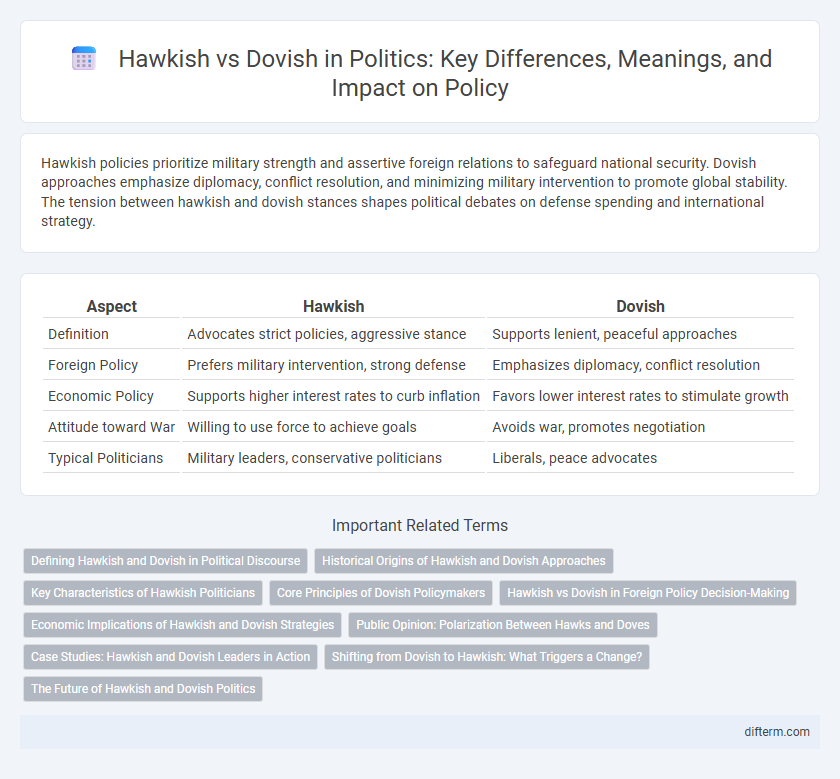Hawkish policies prioritize military strength and assertive foreign relations to safeguard national security. Dovish approaches emphasize diplomacy, conflict resolution, and minimizing military intervention to promote global stability. The tension between hawkish and dovish stances shapes political debates on defense spending and international strategy.
Table of Comparison
| Aspect | Hawkish | Dovish |
|---|---|---|
| Definition | Advocates strict policies, aggressive stance | Supports lenient, peaceful approaches |
| Foreign Policy | Prefers military intervention, strong defense | Emphasizes diplomacy, conflict resolution |
| Economic Policy | Supports higher interest rates to curb inflation | Favors lower interest rates to stimulate growth |
| Attitude toward War | Willing to use force to achieve goals | Avoids war, promotes negotiation |
| Typical Politicians | Military leaders, conservative politicians | Liberals, peace advocates |
Defining Hawkish and Dovish in Political Discourse
Hawkish in political discourse refers to a stance favoring aggressive policies, such as military intervention and strong national defense measures, aiming to confront threats directly. Dovish positions emphasize diplomacy, conflict avoidance, and peaceful resolution, prioritizing negotiations and cooperation over force. These terms shape debates on foreign policy and national security, influencing decisions on war, defense budgets, and international alliances.
Historical Origins of Hawkish and Dovish Approaches
The hawkish approach in politics traces its origins to Cold War era strategies emphasizing military strength and assertive foreign policy to counter perceived threats, exemplified by figures like Senator John Foster Dulles. In contrast, dovish policies emerged from pacifist and diplomatic traditions advocating negotiation and conflict avoidance, influenced by post-World War II efforts to prevent nuclear escalation and promote detente. These historical foundations continue to shape contemporary debates on defense spending, international alliances, and crisis management.
Key Characteristics of Hawkish Politicians
Hawkish politicians prioritize a strong national defense, often advocating for increased military spending and assertive foreign policies to deter adversaries. They emphasize maintaining or expanding military capabilities and may support preemptive strikes or interventionist strategies to protect national interests. Hawkish policymakers typically favor tough stances on security issues and prioritize economic resources toward defense over social welfare programs.
Core Principles of Dovish Policymakers
Dovish policymakers prioritize promoting economic growth and reducing unemployment through accommodative monetary policies, often favoring lower interest rates and increased government spending. They emphasize diplomatic engagement, conflict resolution, and the minimization of military interventions to maintain global stability. Their core principles center on stability, cooperation, and addressing social welfare concerns to foster long-term peace and prosperity.
Hawkish vs Dovish in Foreign Policy Decision-Making
Hawkish foreign policy decision-making emphasizes military strength, aggressive tactics, and a preference for intervention to protect national interests and deter adversaries. Dovish approaches prioritize diplomacy, negotiation, and multilateral cooperation to resolve conflicts and promote global stability. The balance between hawkish and dovish strategies significantly influences international relations, alliance formations, and conflict resolution outcomes.
Economic Implications of Hawkish and Dovish Strategies
Hawkish economic policies prioritize controlling inflation through higher interest rates, which can slow economic growth but stabilize prices and strengthen currency value. Dovish strategies favor lower interest rates to boost employment and stimulate economic expansion, often at the risk of higher inflation. Central banks' choice between hawkish and dovish stances significantly influences investment flows, consumer spending, and overall macroeconomic stability.
Public Opinion: Polarization Between Hawks and Doves
Public opinion on foreign policy reveals a sharp polarization between hawks, who advocate for aggressive military action, and doves, who prefer diplomatic solutions and conflict avoidance. This divide is often reflected in party affiliations and is influenced by factors such as national security concerns, economic interests, and cultural values. Polling data consistently shows that hawkish sentiment surges during times of perceived threats, while dovish opinions gain traction in periods prioritizing peace and international cooperation.
Case Studies: Hawkish and Dovish Leaders in Action
Hawkish leaders like Margaret Thatcher pursued aggressive policies emphasizing military strength and economic austerity, significantly influencing Cold War dynamics and national security priorities. In contrast, dovish figures such as Jimmy Carter championed diplomacy and conflict resolution, promoting arms control agreements and humanitarian interventions during their administrations. These case studies illustrate how hawkish and dovish approaches shape geopolitical strategies and domestic policy outcomes in distinct ways.
Shifting from Dovish to Hawkish: What Triggers a Change?
Central banks shift from dovish to hawkish stances primarily in response to rising inflationary pressures and overheating economic growth signals. Key triggers include sustained increases in core inflation rates above target levels and tightening labor markets driving wage increases. Policy adjustments often involve raising interest rates and reducing asset purchases to cool demand and stabilize price levels.
The Future of Hawkish and Dovish Politics
Hawkish politics emphasize strong defense and assertive foreign policies, often advocating increased military spending and interventionism to address global threats. Dovish politics prioritize diplomacy, conflict resolution, and reducing military involvement, focusing on international cooperation and peace-building efforts. The future of hawkish and dovish politics will likely depend on geopolitical tensions, economic conditions, and public opinion regarding security challenges and diplomatic engagement.
Hawkish vs Dovish Infographic

 difterm.com
difterm.com